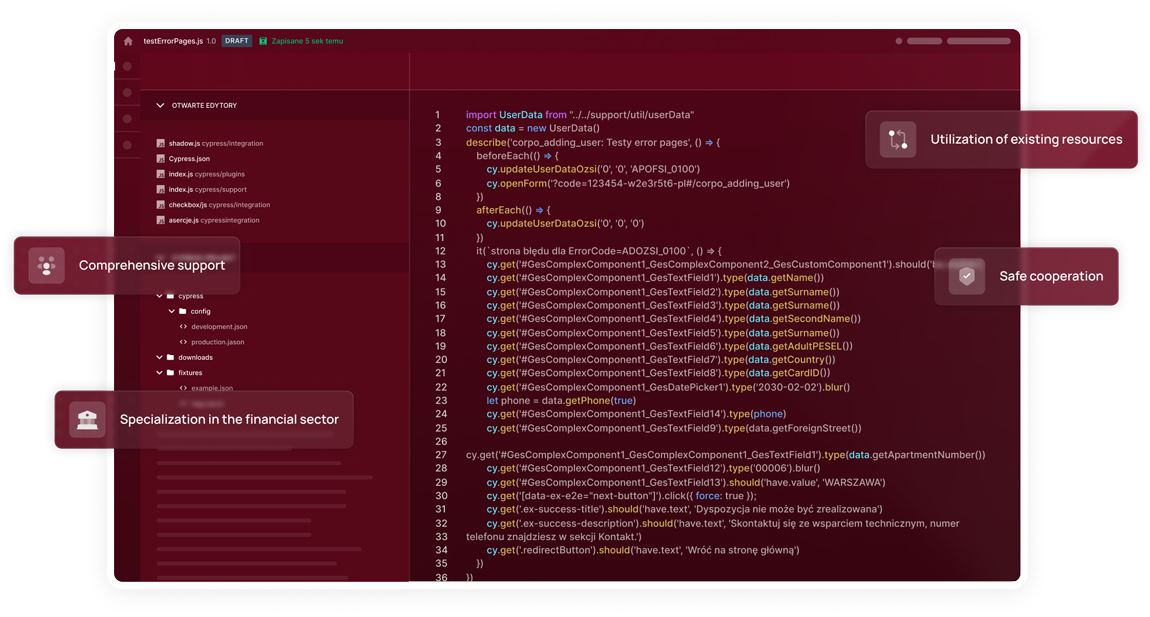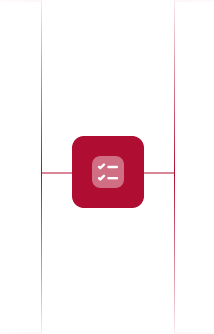


QA and software testing services
Our tech stack
Examples of software test types
QA and software testing
outsourcing models
When?
When you need specialists for short projects and have no need for long-term hiring:
- flexibility
- rapid IT team scaling
- complementary competencies
- cost optimization
When?
When you need expertise in a particular domain only for the duration of a specific project:
- project management by the contractor
- short TTM
- cost optimization
- end-to-end project implementation
Roles in a project
Unleash the power of external QA services
Need specialists for IT projects?
Let's discuss the skills and competencies we can bring to enhance your project.
Numbers
man-hours per year worked in outsourcing projects
outsourcing projects annually
years of experience in the financial industry
years - average period of outsourcing collaboration
years - minimum developer experience
Why do financial organizations choose Consdata?
Specialization in the financial sector
We have been working with the largest financial institutions in Poland for over 20 years. We are well aware of the current challenges of the financial industry and respond to them with effective solutions created by experienced developers.
Business knowledge and leveraging existing resources
We know and understand the business needs of the financial sector. We are capable of integrating with existing systems and processes. We utilize available resources and develop entirely new solutions.
Safe cooperation
The trust of our clients is paramount to us. Alongside prioritizing security and adhering to rigorous standards, we operate in accordance with business ethics, maintain confidentiality, and foster partner relationships.
Comprehensive support and commitment
Our specialists offer support throughout every stage of the production cycle and focus on achieving project goals. They work exclusively on your project, so you can expect total commitment and efficient communication within the team.

What do our clients say?
Our projects
FAQ
Explore the answers to the most common questions about our outsourcing services. If you have other inquiries, feel free to ask.
What are the communication procedures between my team and the team of outsourced employees? What tools are used?
The communication procedures between your team and the team of outsourced employees are transparent and tailored to the financial industry's specifics. Our specialists prioritize secure information exchange and effective communication, adhering to security policies and maintaining confidentiality.
Each project has an assigned Project Manager who serves as the primary point of contact between the bank's team and the outsourced team. They ensure consistent communication and prompt responses to inquiries or issues.
We hold regular status meetings to review progress and plans and address other project-related matters. It is an excellent opportunity to exchange information, identify potential problems, and adjust operational strategies.
What are the qualifications and experience of the IT specialists assigned to my project?
The employees designated for outsourcing projects are hand-picked from a pool of highly qualified professionals. They possess advanced technical skills in programming, data analysis, IT security, application development, and other critical IT domains. They are proficient in using the latest technologies and frameworks.
Moreover, they boast extensive experience collaborating with clients in the financial industry. Their familiarity with the intricacies and demands of the banking sector enhances cooperation effectiveness.
Our teams are distinguished by their creative problem-solving approach, adaptability to rapidly changing conditions, and flexibility.
We hold our employees' communication and interpersonal skills in high regard. Effective collaboration with the bank's team and clear communication are pivotal to the project's successful execution.
Is it possible to adjust the number of outsourced employees according to the current needs?
We understand that IT projects can undergo changes, and we adopt a flexible approach to accommodate our clients' requirements. One of the fundamental aspects of our strategy involves modifying the number of employees based on project demands. Whether it entails increasing or decreasing the team of outsourced personnel, we adapt to factors such as project stage, complexity, or specific requirements.
We collaborate with you to evaluate your present needs and tailor resources accordingly, ensuring optimal outcomes. It gives you control over the project and empowers you to efficiently manage human resources in response to evolving conditions and priorities.
What project and team management methods do you use? What tools are usually employed?
Project management
We employ agile methodologies
such as Scrum and Kanban, enabling the service to adapt flexibly to
evolving project requirements. Regular iterations and sprint meetings
help track progress and adjust strategies.
For projects necessitating a more structured approach, we implement the Prince2 methodology, offering comprehensive control over all project facets, from inception to completion.
Furthermore, we utilize the V-Model, ensuring that testing and implementation processes occur concurrently, thereby enhancing the quality of delivered software.
Jira
Jira stands as one of the primary tools we
use for task management, monitoring work time, and maintaining ongoing
project documentation.
Confluence
The Confluence platform facilitates the creation, sharing, and collaboration on project documentation.
Communicators
For online collaboration and communication, we use platforms such as Slack, Google Meet, Microsoft Teams, and Zoom.
Git/GitHub
We use the Git version control system
and the GitHub platform, which enables efficient source code management
and collaboration between developers.
Miro
Miro serves as a tool for creative tasks such as crafting diagrams, mind maps, and other visual work.
The combination of these methods and tools allows us to effectively manage projects, uphold the quality of delivered software, and ensure complete transparency throughout our collaboration with banks. If necessary, we are also open to adopting client's preferred tools.
What mechanisms are in place for reporting progress and results? Will I have access to up-to-date information on the project?
Our approach to reporting is designed to provide clients with comprehensive insight into the progress of the work and enable monitoring of activities and effective decision-making.
We generate regular reports containing information about achieved milestones, potential problems, changes to the schedule, and further planning. If there are specific requirements for report formats or information frequency, we adjust accordingly.
Each project has a Project Manager who is the first contact person for a client. They handle inquiries, troubleshoot issues, and routinely update the client on project progress.
We hold regular status meetings, presentations, and demos to answer client questions and discuss progress, action plans, and potential challenges.
Our clients have access to project management tools such as Jira, where they can track progress, review schedules, assign tasks, and monitor work time. Additionally, we provide clients with project documentation, including specifications, test plans, technical reports, etc.
How does Consdata foster the professional development of its employees?
We care about employee development through various initiatives:
Chapters
Consdata has chapters, i.e. groups of
specialists in a given field who share knowledge and good practices,
solve problems, verify ideas and develop together. The chapters also
carry out R&D work and other activities that go beyond individual
development goals.
Individual development paths
Employees establish
individual development plans with Chapter Leaders, taking into account
their predispositions, interests, professional goals and the needs of
the team and projects. Synergy between the individual development of
employees and the company's development plans and goals ensures the best
results.
Training budget
It enables employees to participate in courses and workshops related to their specialization.
Subscribe to Pluralsight
Employees have access to
the Pluralsight platform, which offers an extensive online library
containing courses and training materials in the field of the latest
technologies.
Industry conferencesWe support the active participation
of employees in industry conferences, which allows them to gain
first-hand knowledge, establish contacts and follow the latest
developments in the field of IT.
Industry conferences
We support active
participation of employees in industry conferences, which allows them to
gain first-hand knowledge, establish contacts and follow the latest
developments in the field of IT.
Explore new opportunities!
Tell us about your organization's needs. We'll match a fitting collaboration model and assemble the specialists best suited for your project.






